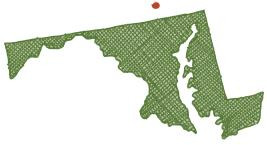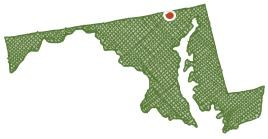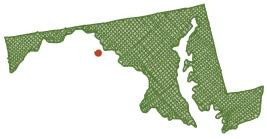
Johns Hopkins UniversityEst. 1876
America’s First Research University
Four places to visit in Maryland this July

Planning your weekend excursions for the month of July? Author Bryan MacKay has the inspiration you need. The following is excerpted from his book, A Year Across Maryland: A Week-by-Week Guide to Discovering Nature in the Chesapeake Region. Be sure to check back next month for MacKay's August recommendations!

Surrounding Gettysburg, Pennsylvania (Adams County)
What to see and do: Perhaps the most significant battle in American history took place during the first three days of July 1863, at Gettysburg, Pennsylvania, just a few miles north of central Maryland. The large battlefield has been faithfully restored and maintained, and the National Park Service offers the opportunity to learn as much about the battle as you wish. To visit in early July and experience the heat and humidity as the soldiers did 150 years ago (except they were wearing heavy, often wool uniforms) heightens one’s appreciation of their valor and dedication to duty. While the battlefield can be toured by auto, perhaps the ideal way to explore the park is by bicycle, where it is a simple matter to dismount to view monuments, explore rarely visited byways, and enjoy fresh air and the sounds of nature. The Gettysburg battlefield is a strikingly attractive rolling landscape of forest and field that is well worth a visit for its natural features, in addition to its great historical significance.
Naturalist’s tip: For years, whitetail deer were protected from hunting in the Gettysburg Park, but they reached a high population density and overgrazed delicate forest vegetation. Finally, when their browsing changed the appearance of the park from what it was in 1863, Park Service officials greatly reduced the herd size. The vegetation responded. Wildflowers soon re- populated the forest floor, tree seedlings began to grow to the sapling stage, and as a result the park now has a more natural appearance.
More information: Visit the National Park Service at www.nps
.gov/gett/index.htm.
Where to see mullein and chicory: Look for the distinctive flower stalk of mullein on any disturbed ground, such as abandoned railroad rights-of-way, steep rocky slopes, and along the shoulders of roads and highways. Interstate 70 in Frederick County seems to have more than its fair share of conspicuous mullein plants. Chicory is one of only a few plants that grows well in cracks in sidewalks, so you can find them even in urban situations, in empty lots and beside sidewalks in Baltimore and certainly along the Rock Creek Trail in Washington, D.C.

27 miles north of Towson (Baltimore County)
What to see and do: The deep shade of hemlock trees overhanging this narrow gorge of the Gunpowder River makes for a cool haven from the heat of summer. Located in extreme northwestern Baltimore County, Hemlock Gorge is not well known and not easy to get to, but is well worth a visit. The water is cold and clear, and there are several good swimming holes. Large boulders covered in moss and algae lend a shaggy and damp sensibility to the river valley. The occasional beam of sunlight sometimes makes it through the dense hemlock branches, briefly illuminating the river like a spotlight, and early morning mists can make a dramatic scene. An unmarked narrow trail that in places is slippery and requires rock scrambling, parallels the river, which ends at the backwaters of Prettyboy Reservoir. Hemlock Gorge itself is only about a third of a mile long, but it packs some photogenic scenery into such a short distance.
Naturalist’s tip: There are still virgin hemlocks in Hemlock Gorge, remnants of precolonial times. A few of these trees are several feet in diameter. However, their existence is threatened by the wooly adelgid, an insect that sucks phloem from young twigs of hemlock trees. Unfortunately, mortality is high in severely infected hemlocks.
More information: See Baltimore Trails, by Bryan MacKay (Balti- more: Johns Hopkins University Press, 2008).

21 miles southwest of Frederick (Frederick County)
What to see and do: Located at the spectacular confluence of the Potomac and Shenandoah Rivers, Harpers Ferry, West Virginia, is a scenic treasure rich with human and natural history. Much of the lower town has been restored by the National Park Service to the way it looked in 1859, and the fascinating museums, displays, and living history enactments are well worth a visit at any time of year. In the heat of midsummer, an enjoyable way to experience the mountain scenery is by tubing down either of the two rivers. Both rivers include lots of easy rapids to bounce and float through, and the water will keep you cool on even the hottest day. It’s an exhilarating yet relaxing way to experience a river from the perspective of a river otter or Canada goose.
Naturalist’s tip: The big silver maples lining the Potomac River near Harpers Ferry harbor plentiful numbers of nesting Baltimore orioles in May through August. Prothonotary warblers, small active golden birds, nest in tree cavities along the C&O Canal; the Harpers Ferry area marks the northwestern edge of the range where they are commonly found in Maryland. The C&O Canal towpath hosts a diverse assemblage of wildflowers throughout the growing season.
More information: To learn more about the historical exhibits of Harpers Ferry, visit www.nps.gov/hafe/index.htm. Details, reservations, and equipment rentals for tubing can be obtained from any of several outfitters in the area. One of the oldest and most experienced of these companies is River and Trail Outfit-
ters, www.rivertrail.com/index.php. Be sure to wear a life jacket. You can be fined for tubing without one, and the National Park Service does patrol the river.

Surrounds of Ohiopyle, Pennsylvania (Fayette County);
46 miles northwest of Frostburg, Maryland
What to see and do: Midsummer is a superb time to visit this rec- reational and natural wonderland in southwestern Pennsylvania. The Youghiogheny River is the living heart of this 20,500-acre park, a wild river that flows clear and clean through long, slow stretches and over rocks, ledges, and drops that form pounding, dramatic whitewater rapids. From the tiny town of Ohiopyle in the center of the park, visitors can join a professionally guided raft trip through rapids like Cucumber, Dimple, and River’s
End. Upriver is ten miles of calmer water, ideal for a family float trip. Paralleling the river in the park is twenty-seven miles of the Great Allegheny Passage, a wide, packed limestone trail that runs from Pittsburgh, Pennsylvania, to Cumberland, Maryland. It’s perfect for bicycling and has beautiful views of the river and riverbank wildflowers. Naturalists are enchanted by the Fern- cliff Penninsula, where hemlocks border the steep slopes along the Yough, shady glens house flowers more typical of Canada than Maryland, and fossil plants can be seen in slabs of sand- stone. For those more interested in culture than nature, Falling- water, architect Frank Lloyd Wright’s most famous house, is nearby and open for tours. There’s no shortage of things to do at Ohiopyle State Park, and summer temperatures and humidity here are significantly lower than in the Baltimore and Washing- ton metropolitan areas.
Naturalist’s tip: The Ferncliff Peninsula Trail, within sight of Ohiopyle Falls, traverses several big blocks of exposed sandstone, some of which have fossilized tree bark plainly visible in them. This area, a National Natural Monument, has good displays of spring and fall wildflowers and is home to species of warblers uncommon in central Maryland.
More information: Visit www.dcnr.state.pa.us/stateparks/finda park/ohiopyle/index.htm.


